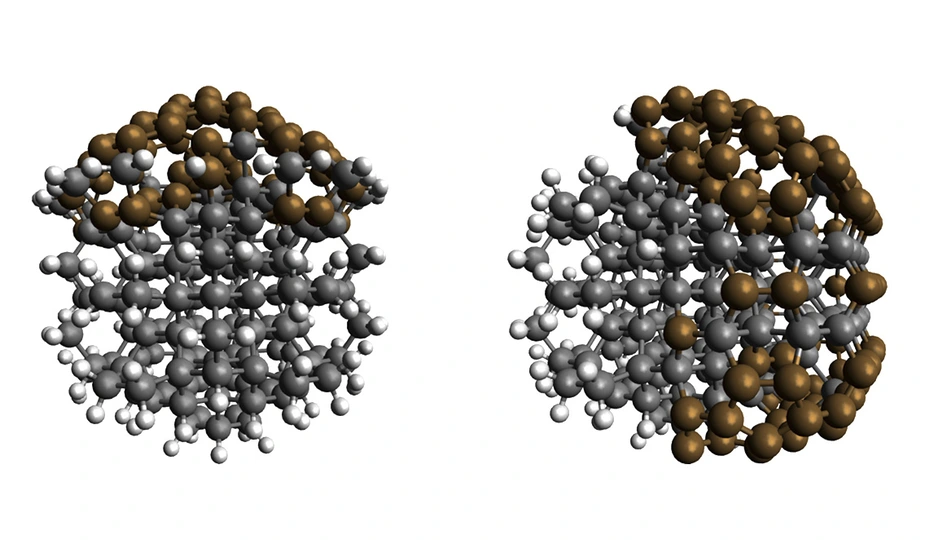Nanodiamonds can be activated as photocatalysts with sunlight
Research team at HZB investigated nanodiamond materials that might be able to convert CO₂ into hydrocarbons or N₂ into ammonia in the future
Nanodiamond materials have potential as low-cost photocatalysts. But until now, such carbon nanoparticles required high-energy UV light to become active. The DIACAT consortium has therefore produced and analysed variations of nanodiamond materials. The work shows: If the surface of the nanoparticles is occupied by sufficient hydrogen atoms, even the weaker energy of blue sunlight is sufficient for excitation. Future photocatalysts based on nanodiamonds might be able to convert CO2 or N2 into hydrocarbons or ammonia with sunlight.
Nanodiamond materials have great potential as catalysts. Inexpensive nanoparticles made of carbon provide very large surfaces compared to their volume. However, to catalytically accelerate chemical reactions in an aqueous medium, electrons from the catalyst need to go into solvation and this requires in pure diamond materials high-energy UV light for excitation. On the other hand, the extremely small sizes of the nanoparticles allow new molecular states on the surfaces of nanodiamonds that also absorb visible light.
Different surfaces
As part of the DIACAT project, a team at HZB has now investigated different variants of nanodiamond materials during excitation with light and analysed the processes with extremely high time resolution. Nanodiamond samples with different surface chemistries were produced by the group of Dr. Jean-Charles Arnault, CEA, France and Prof. Anke Krueger, now at the University of Stuttgart. The nanoparticles differed in their surfaces, which contained different amounts of hydrogen or oxygen atoms.
Hydrogen helps - and fullerene-like carbon too
"The hydrogen on the surfaces makes electron emission much easier," explains Dr Tristan Petit, nanodiamond expert at HZB. "Among the many variants, we discovered that a certain combination of hydrogen as well as fullerene-like carbon on the surfaces of the nanoparticles is ideal," he says.
Ultrafast laser excitations
In the ULLAS femtosecond laser facility at HZB they studied aqueous nanodiamond dispersions with different surface terminations such as hydrogen, -OH or -COOH after exciting them with ultrafast laser pulses. “We were able to experimentally measure exactly how the absorption profile behaves with different excitation wavelengths in the UV range at 225 nm and with blue light in the visible range at 400 nm”, explains Dr Christoph Merschjann, HZB.
Picoseconds after the excitation
"We wanted to find out what happens in the first crucial picoseconds after excitation with light, because that is the time when an electron leaves the surface and goes into the water," says Merschjann. The theory team led by Dr Annika Bande contributed modelling with density functional theory to interpret the spectra. The data showed, as expected, that UV light brings electrons into solution in all samples, but for those samples that had fullerene-like carbon on their surfaces, this was also achieved with visible light.
Blue light can work
"In this work we show – to the best of our knowledge for the first time – that the emission of solvated electrons from nanodiamonds in water is possible with visible light!", Petit summarises the results. This is a decisive step towards opening up nanodiamond materials as photocatalysts. These inexpensive and metal-free materials could be a key to further processing CO2 into valuable hydrocarbons with sunlight in the future, or even to convert N2 into ammonia.
Publication:
Nanoscale (2022): Early dynamics of the emission of solvated electrons from nanodiamonds in water
Franziska Buchner, Thorren Kirschbaum, Amélie Venerosy, Hugues Girard, Jean-Charles Arnault, Benjamin Kiendl, Anke Krueger, Karin Larsson, Annika Bande, Tristan Petit, Christoph Merschjann.
DOI: 10.1039/D2NR03919B
DIACAT has received funding from the European Union's Horizon 2020 Research and Innovation Programme under Grant Agreement no 665085.
Further information:
Helmholtz-Zentrum Berlin für Materialien und Energie
Dr. Tristan Petit
Group Leader
Young Investigator Group Nanoscale Solid-Liquid Interfaces
Phone: +49 30 8062-17153
Email: tristan.petit(at)helmholtz-berlin.de
Dr. Christoph Merschjann
Department Atomic-Scale Dynamics in Light-Energy Conversion
Phone: +49 30 8062-42152
Email: christoph.merschjann(at)helmholtz-berlin.de
Dr. Antonia Rötger
Communication
Phone: +49 30 8062-43733
Email: antonia.roetger(at)helmholtz-berlin.de
Press release HZB, 30 November 2022
